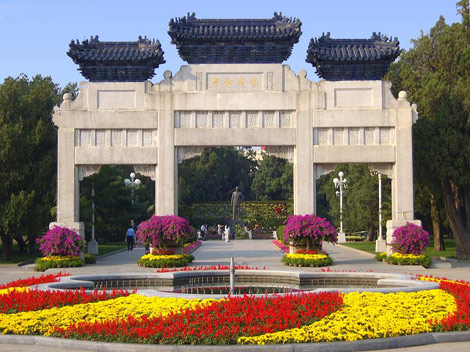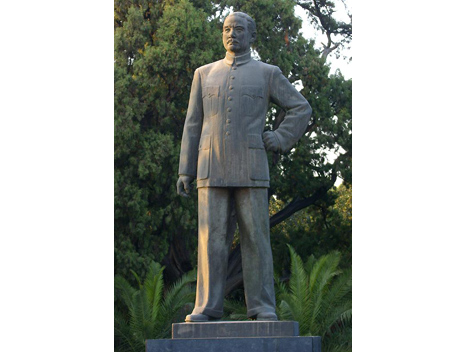more>>More News
- National Day
- ways to integrate into Chinese style life
- Should they be in the same university with me?!!
- Chinese Ping Pang Legend: the Sun Will Never Set
- A Glance of those Funny University Associations
- mahjong----The game of a brand new sexy
- Magpie Festival
- Park Shares Zongzi for Dragon Boat Festival
- Yue Fei —— Great Hero
- Mei Lanfang——Master of Peking Opera
Beijing Zhongshan Park
By admin on 2015-01-22
Zhongshan
Park 中山公园 is located to the west of
Tian’anmen Rostrum in the heart of the Inner City. It is the site of the former
Altar of Land and Grain. Entering through the main southern entrance, one
comes to a large vestibular pavilion with long corridors running off to the east
and west. In front of the pavilion is a white marble memorial archway erected by
the Qing government to commemorate the German Minister Baron von Kettler, who
was killed during the Yihetuan Movement (“Boxer Rebellion”) in 1900. This
archway originally stood outside the western entrance to the Xizongbu Alley, but
after Germany’ s defeat in World War I, it was removed to the Zhongshan Park and
inscribed with the words“Triumph of Righteousness”(Gongli Zhansheng). After 1949
it was rein scribed in Guo Moruo’ s handwriting with“Defeat the Peace”(Baowei
Heping). To the east stands a beautiful specimen of Taihu Lake
stone known as“a slice of dark clouds,” which was moved here from Yuanmingyuan.
Emperor Qianlong composed its inscription. There is a peony pond, a wisteria
arbor and, to the north, a grove of cypresses with trees said to have been
planted in the Liao Dynasty. Seven of the trees are so large that it takes three
of four persons with arms outstretched to encircle the trunk. One of the
cypresses on the eastern side is particularly unusual, because a scholar trees
is called “the embrace of the scholar tree and the cypress.” The path that runs
through the archway is lined with umbrella-like scholar trees and verdant
pines. On the southern side of this east-west path lies a
greenhouse with fresh flowers on display all year round. Included are 39
varieties of tulips presented to the park in 1977 by the Princess of Holland.
The eight “Orchid Pavilion” stela, standing inside a hall nearby, are engraved
in the hand of Emperor Qianlong with the text of a famous preface to a
collection of poems entitled the Orchid Pavilion. The Pavilion Where the RITES
Are Practiced was moved to the Zhongshan Park from the Honglu Court, an office
which during the Ming and Qing dynasties. In imperial times all officials coming
to the capital to be received by the emperor for the first time went first to
the Honglu Court to learn the proper protocol. To the south of this path there is also a display of
rare goldfish. Further south, one comes to the quietest spot in the park, the
area of the Lotus Pool, Water-side Pavilion, Pavilion of Four Contentment and
the Pavilion to Welcome the Sunshine. On the north side of the path is the Altar of Land
and Grain. Here the landscape is particularly charming. With the lofty Concert
Hall to the east and the Health Education hall to the west. The area is planted
with numerous fruit trees, herbaceous peonies and green lawns. A wide path
through the center of the lawns leads to the altar. To the east of the altar is the Pavilion of the Pines
and Cypresses and a tall rockery. Footpaths lead to secluded nooks and wind
their ways to the cross-shaped Touhu Pavilion, which takes its name from an old
game of throwing arrows into a pot. South of this building lies the Kiosk for
Meeting New Friends (Laijinyuxuan) where refreshments are sold. To the west of the Altar of Land and Grain is the
liveliest part of the park. Here among a forest of cypress trees stand
artificial hills, thatched pavilions, a teahouse, a restaurant, a children’ s
playground and an amusement park. To the north of the altar past the Zhongshan Hall is
another copse of cypress trees, among which is a stone table built of hollow
bricks dating from the Han Dynasty. The classically elegant designs on the old
bricks are still quite distinct. The moat (Tongzihe or Tube River) is also known
as the Imperial River (Yuhe) and is used for ice skating in the winter and
boating during the summer and autumn. Over 1,000 years ago the site of Zhongshan Park was
the Temple of National Prosperity, which stood in the northeast suburbs of
Yanjing, the Liao Dynasty capital. Under the Yuan Dynasty, the name of the
temple was changed to the Temple of Longevity and National Prosperity. Although
no traces of the old buildings remain, the ancient cypresses planted inside the
temple serve as a reminder of those days. In 1421, the Ming Emperor Yongle built
the Altar of Land and Grain symmetrically opposite the Imperial Ancestral
(Taimiao) Temple, which stands to the east of Tian’anmen Rostrum. In 1914, the
altar was renamed Central Park and opened to the public on October 10. In 1928,
the park was renamed Zhongshan Park in tribute to the memory of Sun
Yat-sen.

- Contact Us
-
Tel:
0086-571-88165708
0086-571-88165512E-mail:
admission@cuecc.com
- About Us
- Who We Are What we do Why CUECC How to Apply
- Address
- Study in China TESOL in China
Hangzhou Jiaoyu Science and Technology Co.LTD.
Copyright 2003-2024, All rights reserved




 Chinese
Chinese
 English
English
 Korean
Korean
 Japanese
Japanese
 French
French
 Russian
Russian
 Vietnamese
Vietnamese
